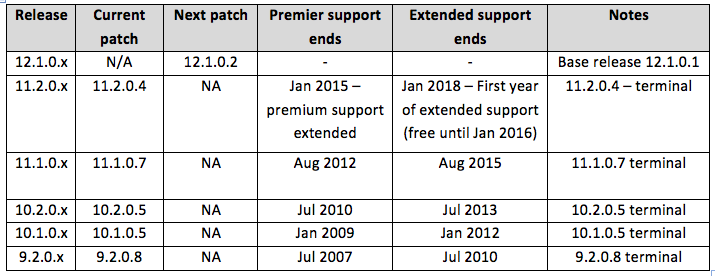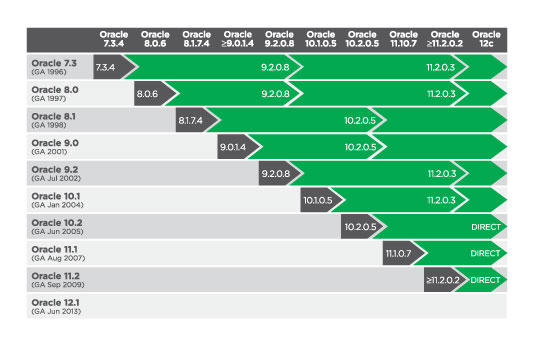Mike Stone (@HoBMStone), CIO & Principal Architect
Making the decision to upgrade to the latest version of Oracle can be a complex process for many organizations. In this blog, I discuss a variety of factors, including Oracle version support, new features, upgradability and stability, which can help you decide whether or not upgrading to Oracle 12c is the right move for your organization in 2015.
Oracle Database Support
The following chart summarizes the support dates for the various versions of Oracle’s database software and when support ends for both the Premier and Extended support levels.
- Premier support is available for the first 5 years after the product is generally available. With this level of support, Oracle will help the customer with any issues/bugs and will develop patches as necessary. They will also supply Critical Patch Updates (CPUs) and/or Patch Set Updates (PSUs).
- Extended support is available for an additional cost and is available for 3 years after Premier support ends. While no new patches will be developed for bugs, CPUs and PSUs will still be available.
- Lifetime support – As long as you are paying for support, even for older software versions, you have the right to open a support ticket. Oracle Support will attempt to help on a best efforts basis. However, no new patches will be developed including CPUs and PSUs. Any existing patches will still be available to you. Technically, only terminal releases are supported under this level of support.
12c New Features
Several new features were introduced the release of Oracle 12c. Below I offer a summary of these new features. A more detailed list of these new features can be found in the Database New Features Guide at: https://docs.oracle.com/database/121/NEWFT/toc.htm.
Among a host of other useful improvements, the following jumped out when I was reviewing the Database New Features Guide:
- Many new features for managing data and storage growth, including column-level and advanced index compression, as well as in-memory caching of column data formerly reserved for the Exadata world.
- Improved compression and archiving
- Improvements to Pluggable Database (PDB)
- Improved support for mobile applications
- Enhanced globalization
- Enhanced development support
- Enhanced OLAP
- Automated adaptive performance tuning
- Improved manageability through Oracle Cloud Control 12c
Upgradability
Oracle only maintains direct upgrade ability for three major releases. The version upgrade matrix below, courtesy of Mythics.com, can help walk you through the Oracle Database upgrade path.
Determining Factors for Upgrading to 12c
- Stability: 12.1 was released in July of 2013, so there’s been some water under the bridge. The next release is 12.1.0.2 and in our experience it’s likely to be a good one.
- Functionality: In-memory caching, compression and column store are introduced in 12c. This offers performance technology formerly exclusive to the Exadata platform – for a fee…
- Support Cost: Beginning in January of 2016, the cost of extended support for 11.2 is likely to increase.
- Upgradability: Oracle only maintains direct upgrade ability for three major releases. In other words, only 10.2 and newer will be able to upgrade directly to 12c.
- Support for the latest Oracle products: 11.2 is now on extended support, which means that the latest Oracle software products are no longer supported on 11g.
Conclusion
While many organizations delay upgrading their Oracle databases as long as possible, in this blog I discussed some compelling reasons for upgrading to 12c in 2015.








